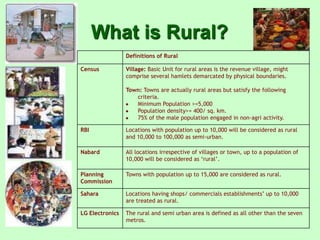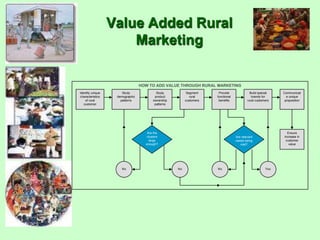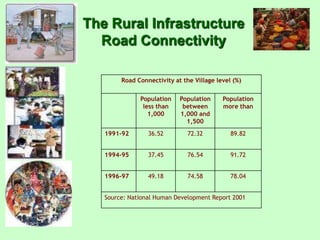RURAL MARKETING
- 1. Rural Marketing BY ASHA PRIYA GOUD
- 2. Why Rural Marketing is hot? Rural Push Policy of UPA Government Four Consecutive years of positive growth in rural GDP 40% hike in MSP of Crops over last two years Farm Loan Waiver & NREGS Growing Industry Demand for land (Overnight Wealth) Big rise in remittances from Cities Slowing urban demand forcing corporates to rural markets
- 3. % Annual Change in Rural GDP Year Change 2003-04 10% 2004-05 -6.7% 2005-06 5.8% 2006-07 4% 2007-08 4.9% 2008-09 (Estimates) 2.6% 51% 49% Rs. 13,65,000 Rs 13,17,018 Crore Crore
- 4. Why Rural Marketing is a New Discipline? Rural Marketing is a new discipline because: India is a predominantly agrarian society. Western Marketing has no experience to manage it. Urban markets are saturating in India. There are immense opportunities at the bottom of the pyramid. R. M. can change rural business. Retail boom will also expedite the growth of rural marketing.
- 5. What is Rural? Definitions of Rural Census Village: Basic Unit for rural areas is the revenue village, might comprise several hamlets demarcated by physical boundaries. Town: Towns are actually rural areas but satisfy the following criteria. Minimum Population >=5,000 Population density>= 400/ sq. km. 75% of the male population engaged in non-agri activity. RBI Locations with population up to 10,000 will be considered as rural and 10,000 to 100,000 as semi-urban. Nabard All locations irrespective of villages or town, up to a population of 10,000 will be considered as ‘rural’. Planning Commission Towns with population up to 15,000 are considered as rural. Sahara Locations having shops/ commercials establishments’ up to 10,000 are treated as rural. LG Electronics The rural and semi urban area is defined as all other than the seven metros.
- 6. What is Rural Marketing? According to the National Commission on Agriculture: „Rural Marketing is a process which starts with a decision to produce a saleable farm commodity and it involves all the aspects of market structure or system, both functional and institutional, abase on technical and economic considerations and includes pre and post harvest operations, assembling, grading, storage, transportation and distributions‟. “Rural Marketing can be defined as a function that manages all activities involved in assessing, stimulating, and converting the purchasing power of rural consumers into an effective demand for specific products and services and moving these products and services to the people in rural areas to create satisfaction and a better standard of living and thereby achieving organizational goals.” -Pradeep Kashyap
- 7. Scope of Rural Marketing The Rural Marketing Matrix (Market) Urban Brand Consumables and durables (Organised) Rural Farm & Non-Farm and services (Unorganised Sector) Handicrafts, Handloom Textiles, Leather products (Semiorganised) Rural Urban (Production)
- 8. Evolution of Rural Marketing Phase Origin Function Major Products Source Market Destination Market I Since independence Agricultural marketing Agricultural produce Rural Urban II Mid-Sixties Marketing of agricultural inputs Agricultural inputs Urban Rural III Mid-Nineties Rural marketing Consumables and durables for consumption and production Urban/ Rural Rural IV 21st Century
- 9. Nature of Rural Marketing (Transactional Vs Development Marketing) S. No. Aspect Transactional Development 1 Concept Consumer orientation, Marketing concept Society orientation, societal concept 2 Role Stimulating and conversional marketing Catalytic and transformation agent 3 Focus Product-market fit Social change 4 Key task Product innovations and communications Social Innovations and communications. 5 Nature of activity Commercial Socio-cultural, economic 6 Participants Corporate enterprises, Sellers Government, voluntary agencies, corporate enterprises, benefactors 7 Offer Products and services Development Projects/Schemes/Programmes 8 Target group Buyers Beneficiaries and buyers 9 Communication Functional Development 10 Goal Profits Customer satisfaction Brand image Market Development Corporate Image 11 Time-Frame Short-Medium Medium-Long 12 Motivation Profit-motive Business policy Service-motive Ideological or Public policy
- 10. Taxonomy of Rural Markets (Classification of Rural Markets) Constituents Products Durables Services Consumer Market Individuals and households Consumables: Foods products, Toiletries, Cosmetics, Textiles and Garments, Foot Wear etc. Watches, Bicycles, Radio, T.V., Kitchen appliances, Furniture, Sewing machines, Two Wheelers etc. ------- Industrial Market Agricultural and allied activities, Poultry farming, Fishing, Animal, Husbandry cottage industries, Health Centre, School, Cooperatives, Panchayat office etc. Consumables: Seeds, Fertilizers, Pesticides, Animal feed, Fishnets, Medicines, Petrol/Diesel etc. Tillers, Tractors, Pump sets, Generators, Harvesters, Boats etc. ------- Services Market Individuals, House holds, Officers, and Production firms ------- ------- Repairs, Transport, Banking, Credit, Insurance Health care, Education, Communication , Power etc.
- 11. Whether Rural Markets are Attractive? Large population Rising prosperity Growth in consumption Life-style changes Life-cycle advantages Market growth rates higher than Urban Rural marketing is not expensive Remoteness is no longer a problem.
- 12. Rural Vs Urban Marketing S. No. Aspect 1 Philosophy 2 Market (a) Demand (b) Competition (c) Consumers o Location o Literacy o Income o Expenditure o Needs o Innovation adoption 3 Products o Awareness o Concepts o Positioning o Usage method o Quality preference o Features Urban Rural Marketing and societal concepts, Green marketing and relationship marketing Marketing and societal concepts, development marketing, and relationship marketing. High Among units in organized sector Low Mostly from unorganized units Concentrated High High Planned, Even High level Faster Widely spread Low Low Seasonal variations Low level Slow High Known Easy Easily grasped Good Important Low Less known Difficult Difficult to grasp Moderate Less Important Contd.
- 13. Rural Vs Urban Marketing – Contd. S. No. Aspect Urban Rural 4 Price o Sensitive o Level desired Yes Medium-High Very much Low-Medium Wholesalers, Stockists Retailers, Supermarkets, Specialty stores and authorized show rooms Village shops Shandies Haats and Jatras Good High Average Limited Print audio-visual media, out doors, exhibitions etc. Few languages TV, Radio, Print Media to some extent. More languages o Personal Selling Door-to-door frequently Occasionally o Sales promotion Contests, Gifts, Price Discounts Good opportunities Gifts, Price discounts 5 Distribution o Channels o Transport facilities o Product availability 6 Promotion o Advertising o Publicity Less
- 14. Value Added Rural Marketing HOW TO ADD VALUE THROUGH RURAL MARKETING Identify unique characteristics of rural customer Study demographic patterns Study product ownership patterns Segment rural customers Provide functional benefits Are the clusters large enough? No Build special brands for rural customers Ensure increase in customer value Are relevant needs being met? No No Communicat e unique proposition Yes
- 15. SESSION II Rural Marketing Environment & Rural Economy
- 16. Structure of Rural Markets Demographic Environment 1971 Total population (million) 1981 1991 2001 548.2 683.3 848.3 1026.9 524.0 628.8 741.6 Rural population (million) Rural Proportion to total population (%) 80.1 76.7 74.3 72.2 Decadal Variation - 19.8 16.7 15.2 Source: Census of India 2001
- 17. Education and the Level of Demand Rural Literacy % of literates 1981 1991 2001 36 45 59 Source: Census of India 2001
- 18. Household Pattern Family Structure Particulars 1991 2001 Rural Urban Total Rural Urban Total Households (Million) 112 40 152 138 54 192 Family Size (Number) 5.55 5.32 5.36 5.31 Source: Census of India 2001
- 19. Rural Housing Pattern House Type 1981 1991 2001 Pucca (%) 22 31 41 Semi-Pucca (%) 37 36 36 Kuccha (%) 41 33 23 Total 100 100 100 Source: Census of India 2001
- 20. Occupational Pattern Distribution of Households by Occupation of the Head, 1999-2000 Head’s Occupation Distribution of households (%) Urban Rural All Housewife 0.84 1.01 0.96 Cultivator 3.45 40.86 29.99 Wage earner 20.93 35.28 31.12 Salary earner 40.72 11.28 19.84 Professional 3.59 0.73 1.56 Artisan 6.90 3.41 4.42 Petty Shopkeeper 16.05 4.97 8.19 Businessman 3.68 0.46 1.40 Other 3.85 1.98 2.52 Total 100.00 100.00 100.00 Source: NCAER 2002
- 21. Physical Environment Rural and Urban Life: Distinguishing Features Population Density (Urban + Rural) (Per Sq. Km.) 1971 1991 177 216 267 312 171 Popu. Density (Total) 1981 214 253 Rural 2001 Distribution of Towns and Villages 1991 No. of Towns No. of inhabited Villages Total no. of Villages 2001 3,697 5,161 580,779 593,154 634,321* 638,588* * The total number of Villages also includes non-inhabited Villages. Source: Census of India 2001
- 22. Settlements (Scattered and Clustered) Town class Population No. of Towns % of total Towns % of Population Decadal Growth (1991-2001) Class-I 1 Lakh and above 423 8.2 61.5 24 Class-II 50,000 – 99,999 498 9.6 12.3 15 Class-III 20,000 – 49,999 1,386 26.9 15.0 16 Class-IV 10,000 – 19,999 1,560 30.2 8.1 7 Class-V 05,000 – 09,999 1,057 20.5 2.8 8 Class-VI Less than 5,000 237 4.6 0.3 -22 5,161 100.0 100.0 Total * 10 Lakh + : 27; 5-10 Lakh: 42; 1-5 Lakh:354 Source: Census 2001
- 23. Economic Environment 80 -70 -- 67.3 % Households 60 -50 -42.7 40 -- 39.5 42.5 36.9 30-20-- 23.9 17.8 20.6 10-0-- 8.8 1989-90 _________ Low (<Rs.45K p.a) _________ High (>Rs.90k p.a) 2001-02 2009-10 ________ Middle (Rs.45K-90K p.a) Source: Market Information Survey of Households, NCAER
- 24. Changing Rural Consumers Expenditure Pattern Per capita consumption expenditure (Rs. Per month) Rural Urban 1983 112 166 1991 281 2001 486 Composition of rural per capita consumption expenditure Source: NSSO Food Non-Food 1983 66 34 458 1991 63 37 855 2001 59 41 Source: NSSO
- 26. Size of Rural Market Estimated Annual Size : Rural Market FMCG Rs. 65000 Crore Durables Rs. 5000 Crore Agri-inputs (incl. tractors) Rs. 45000 Crore 2/4 Wheelers Rs. 8000 Crore Total Rs. 1,23,000 Crore Source: Francis Kanoi 2002
- 28. The Economic Scenario in Rural India Human Development Index (HDI) Year Rural Urban Total 1981 0.26 0.44 0.30 1991 0.34 0.51 0.38 2001 ------ ------ 0.47 Source: Human Development Report, 2001 The HDI is a composite of variables capturing attainments in three dimensions of human development, viz., economic, educational and health.
- 29. The Changing Face of Rural Development Population below the poverty line (Rural) Period No. of Persons (Million) % of Persons Poverty line (Rs.) 1983 252 46 89.5 1993-94 244 37 206 1999-2000 193 27 328 Source: Human Development Report, 2001
- 30. The Development Exercise: The Five-Year Plans Sectoral allocations during the five-year plans (Rs. Billion) Head of Development Seventh Plan Eighth Plan Ninth Plan Tenth Plan (1985-90) (1992-97) (1997-2002) (2002-07) 1. Agriculture 105 225 372 589 2. Rural Development 89 344 890 1,219 Source: Planning Commission 2002 Percentage share of the different sectors in GDP (at 1993-94 prices) Year Primary (Agri and Allied) Secondary (Manufacturing) Tertiary (Services) Total 1950-51 57.2 14.8 28.0 100.0 1980-81 39.7 23.7 36.6 100.0 2001-02 23.9 26.6 49.5 100.0 Source: National Account Statistics, 1951-2001
- 31. Transition of the Rural Economy 1. Food grain crops 1. Non-food grain crops, cash crops 2. On-land activities 2. Off-land allied activities like livestock and fisheries 3. Farm activities 3. Non-farm activities, including manufacturing and services.
- 32. The Rural Economic Structure Rural Economy Farm Sector (Agri & Allied) Non-Farm Sector (Formal & Informal Sector) Agriculture Rural Industries Rural Services Animal Husbandry (Dairy, Goat, Poultry) Agro Processing (Sugarcane, Oilseed etc) Retailing & Trading Horticulture Forestry Fishing Manufacturing (Handloom, Handicrafts etc) Mining & Quarrying Construction Community & Social Service Transport & Storage Communication
- 33. Income Disparity Rural-Urban Income Comparison Sector Population (Million) Middle (40%) Rural Average Consumption Expenditure (Rs./Annum) Bottom (30%) Urban Rural Urban Rural Urban Rural Urban 3,270 4,580 5,110 8,150 9,400 18,720 5,830 10,260 223 86 297 114 223 86 742 285 Source: NSS 55th Round (1999-2000), Census 2001 Top (30%) All Classes
- 34. The Rural Infrastructure Road Connectivity Road Connectivity at the Village level (%) Population less than 1,000 Population between 1,000 and 1,500 Population more than 1991-92 36.52 72.32 89.82 1994-95 37.45 76.54 91.72 1996-97 49.18 74.58 78.04 Source: National Human Development Report 2001
- 35. Telephone Services Telecom Density (Phone per 100) 2000 2005 Increase Urban 8.2 26.2 220% Rural 0.7 1.74 148% All 2.9 9.08 213% Source : Telecom Regulatory Authority of India Report, 2005
- 36. Why Agriculture Growth has been slow & tardy? 1. 2. 3. 4. 5. 6. 7. Low priority to Agriculture Subsistence Orientation of Agriculture Failure of Land Reforms Low size of operational Landholdings Inadequate Food Supplies Sluggish Infrastructural Growth Disconnect between Research & Farmers 8. Insufficient Availability of Credit 9. Inadequate Inputs 10. Slowdown of Rural Industrialization
- 37. Policy Interventions Required 1. 2. 3. 4. 5. 6. 7. 8. 9. 10. Thrust on Land Reforms Strengthening the Panchayati Raj Institutions Financial Inclusion (Innovative Credit Delivery) Development of Rural Infrastructure Expansion of Kisan Credit Card Scheme Protection of Farmers from natural calamities Extensive use of ICT Higher Investment in Agriculture & Rural Development. Focus on High Value Crops & Non-farm Incomes. Bridging the Gap Between Agri-Research & Farming.





































